Introduction

nnovation is at the centre of the current economic policy discourse in Canada. Innovation drives productivity and with it, standards of living. Innovation is the process of using ideas, typically in the form of intellectual property (IP), to offer new or improved products or services for the same or lower overall cost of production.
The preoccupation with innovation is driven by a number of factors, of which two are most significant. First, productivity performance in Canada has been disappointing: in 2015, it stood almost exactly where it was 30 years earlier in 1985. Other indicators also suggest a malaise in innovation. Canadian inventors living outside the country appear to be more productive than those living in Canada, and Canada’s emigration appears to be more innovation-rich than its immigration.1 In recent years, the contribution of total factor productivity as the measure of innovation to Canada’s economy has been zero or negative.2
Second, the nature of value creation has changed, with intangibles and ideas gaining in importance. This, in turn, has implications for what drives competitiveness and trade — important for a country where international trade matters as much as it does in Canada.
Innovation is the process of using ideas, typically in the form of IP, to offer new or improved products or services for the same or lower overall cost of production.
With productivity trending flat and the nature of production changing, more of the same is not an option as Canada risks being left behind in the global knowledge economy. Canadians have an enviable standard of living, and economic policy has surely contributed to this state of affairs. The emphasis on trade agreements, a laissez-faire policy (in particular in what used to be called “industrial policy”) and generous (by international standards) funding for science and technology and universities are key. But at the end of the day, productivity is what it is — flat over three decades. Periods of buoyant raw materials prices and a growing population fuelled by immigration have also played key roles in rising living standards, suggesting that the actual impact of policy on productivity has been modest.
The series of essays that this overview introduces marshalls new thinking on innovation, and brings together a community of scholars and practitioners who offer fresh approaches to innovation in Canada, and Canada’s place in the world. The next two sections set out the key features of productivity performance and the ideas economy. The final section introduces the rest of the essays and proposes a framework for policy responses to the innovation conundrum — keeping in mind that it is early days in this new approach.
Productivity
Labour productivity is measured by real GDP per hour worked. It is a simple measure of productivity; it does not account for changes in capital deepening (capital per hour worked) or labour composition (percentage of the growth that comes from more highly skilled workers). Because of these omissions, growth in labour productivity will generally be larger than other measures of productivity.
Capital deepening3 is measured by the volume of capital input per hour worked; capital input is measured by the capital services provided by an asset multiplied by the cost per unit of an asset’s capital service. It is a measure of the capital intensity of production; more capital deepening implies higher labour productivity. The measurement does not capture the impact of growth in capital services on output and it is subject to a wide margin of error due to aggregation of asset types and averaging of the cost of capital service.
Multifactor productivity is the change in output that cannot be explained by changes in the quantities of capital and labour inputs used to generate output. It is the best measure there is for understanding changes in output caused by improvements in technology. In other words, multifactor productivity portrays innovation as the use of ideas to increase prosperity and standards of living.
This is the measure that has been so disappointing in recent years. As Figures 1 and 2 show, following a period of growth in the 1960s and 1970s, productivity has fluctuated, but in 2015 it was essentially the same as it was in 1985. Some sectors have done better than others (see Figure 3), but in the aggregate, the gainers have just balanced the losers. As Figures 4 and 5 show, this performance puts Canada in the bottom range of the pack internationally.
Figure 1: Historical Growth in Canada’s Multifactor Productivity (1961=100)
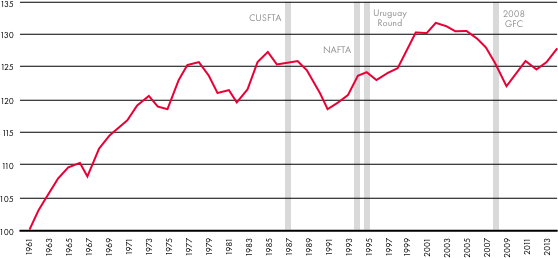
Figure 2: Growth in Canada’s Multifactor Productivity, 1985–2014 (1985=100)
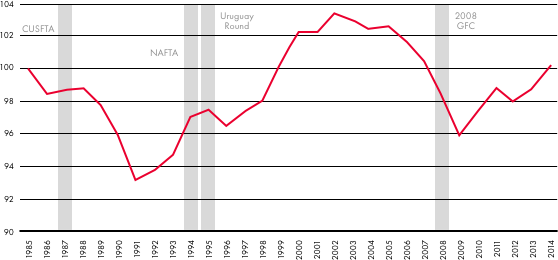
Figure 3: Historical Growth in Canada’s Multifactor Productivity by Industry (1961=100)
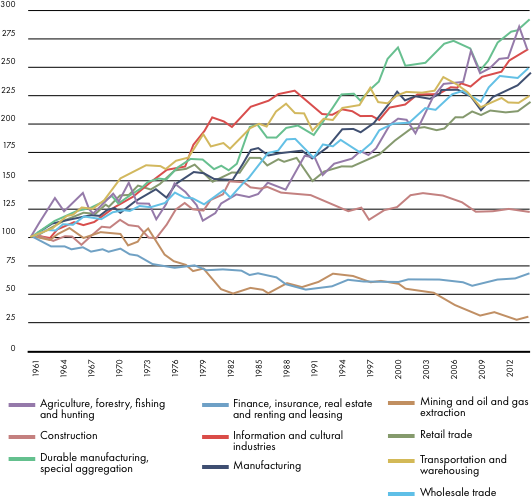
Figure 4: Multifactor Productivity Growth by Country
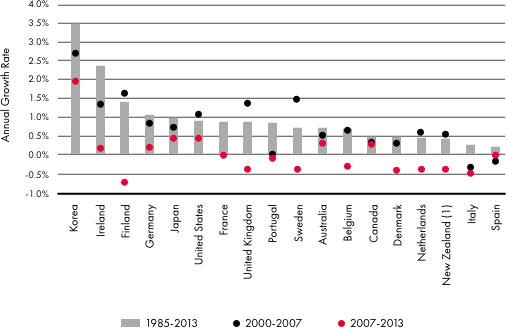
Figure 5: Multifactor Productivity Growth Trends by Country (1985=100)
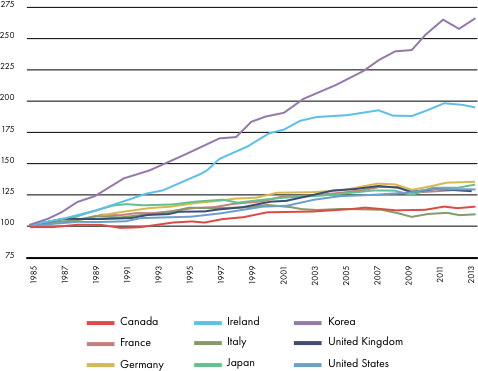
There are no empirical studies that measure the determining factors of Canada’s multifactor productivity growth. Since multifactor productivity is treated as a residual in the growth accounting framework, its determinants cannot be easily identified. It captures technological advancement, organizational change, economies of scale and complementarities from the relative composition of usage of human, physical and technological capital (Baldwin and Gu 2007, 10).4
Studies that consider historical trends in multifactor productivity growth in Canada have analyzed its dynamics by industry, capital input, labour contribution (see, for example, Baldwin and Gu 2007) and province (see, for example, de Avillez and Ross 2011). These studies reveal that multifactor productivity was high in the 1960s, as the postwar period was associated with rapid capital formation, new technologies and increased international trade. Productivity growth subsequently declined from around 1973 to 1989, and then picked up in the 1990s as the information and communications technology revolution took hold. There has been a significant slowdown over the last 15 years. But for the most part, the drivers of multifactor productivity growth in Canada are largely unknown, so that appropriate policy responses to stimulate it are often conjecture.
The Ideas-driven Economy
For an indicator of the importance of ideas in today’s economy, consider what has happened to companies comprising the Standard & Poor’s (S&P’s) 500. In 1975, one-sixth of the S&P 500 represented the value of intangibles; today the figure is five-sixths (see Figure 6). To be sure, intangibles and IP are not exactly the same thing — the former also comprises, for example, goodwill and brand recognition. But as an indicator of the relative decline of the value of physical assets and the rise of technological advance and organizational change, the magnitude of the shift is telling.
Figure 6: Shifting Tangible and Intangible Asset Ratios of S&P 500 Market Value 1975–2015
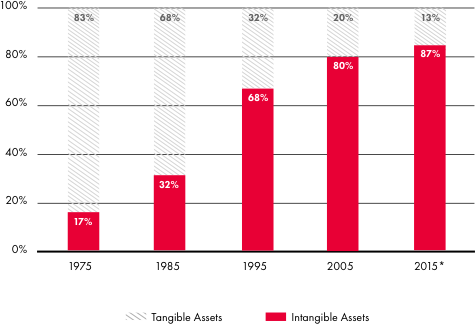
The process of innovation has three basic stages: (1) attracting and developing talented people; (2) creating knowledge through research; and (3) developing and marketing new products and services. In the first two stages of the innovation process, Canada’s policies include a general objective of building a skilled workforce by boosting post-secondary education, and targeted funding aimed at attracting international talent and developing scientific research capacity (scholarships and fellowships). In order to translate research into innovation, the government has focused on creating fiscal incentives (targeted grants, taxes and subsidies) and supporting institutional facilitators (granting institutions, and accelerators and incubators). External policies are also a central component of Canada’s innovation strategy. Immigration programs have focused specifically on attracting talented people by minimizing the procedural requirements to immigrate to and work in Canada (for example, the Express Entry system for skilled workers, and Start-up Visa Program5), while free trade and investment accords aim to attract investment to Canada and to open up the global market for Canadian innovations.
In some respects, Canada’s policies have been successful. Notwithstanding the results cited at the start of this essay, Canada has a strong record of attracting and developing talented individuals and conducting high-level research (Council of Canadian Academies 2013) and it scores well in access to funding, regulatory landscape, education and entrepreneurial culture (EY 2013). Measured by inputs (research and development expenditure, grants, subsidies and education), Canada is internationally competitive. However, measured by its outputs (revenues from the sale of new products or medium-term growth of start-ups), Canada falls flat. It is in the final stage of the innovation process — that is, the actual innovation — where Canada’s performance suffers.
Canadians have made significant contributions to the advancement of new technologies, such as the internet search engine, the touch screen and the video/picture-sharing service, but the commercialization of these technologies has taken place elsewhere. Successful participation in the IP-driven economy means optimizing the commercial and other spinoff benefits of inventions that occur in Canada. The essays in the New Thinking on Innovation series are meant to focus attention on a range and mix of practical public and private sector interventions that would help make this happen consistently and well. Many of these have to do with national strategy and action at the national level, rather than global cooperation. But there is also the global dimension, in areas such as norms and standards around sentient technologies, the global IP regime and international trade agreements. Canada played a central role in shaping the global order that created the current gamut of institutions in the trade, finance and security arenas — could it do the same for the global ideas economy?
It is in the final stage of the innovation process — that is, the actual innovation — where Canada’s performance suffers.
How Canada participates in the “rules of the game” for the internet, blockchain, biotech and sentient computing, for example, will set the course for Canada’s prosperity in coming decades. This will involve a set of policy actions that focus on translating inputs into innovation. Such a strategy would recognize that the new economy places greater value on intangible assets than tangible assets.
Trade in ideas does not embody the same characteristics as trade in goods and services (see Breznitz 2016). It is characterized by high upfront costs, and very low reproduction costs. It conveys a great advantage to first movers, particularly if the technology becomes an industry standard. This also means that primacy in this matter is a global geopolitical game. And economies of agglomeration are inherent in the production of IP, so existing innovation clusters have a head start over others still in the formative stage.
International Trade, Domestic Policy and Global Processes
The essays in this series are grouped into three blocks. The first block covers the role that international trade plays in stimulating innovation. The central points here are that “free trade” agreements are as much about managing trade (in goods and services) as they are about reducing barriers to it. More importantly, as the centre of gravity in international trade shifts from goods and services to ideas and the IP they embody, the nature of trade agreements, and how countries approach negotiating them, must change.
The second block of essays turns to domestic policy, exploring a series of issues such as the impact of patent regimes on innovation, the concept of a sovereign patent fund, using government procurement strategically, unlocking the IP currently residing mostly unexploited in universities, and an IP-centred curriculum in law and business schools, with particular attention to educating Canada’s cleantech entrepreneurs, who are falling behind on commercialization. In addition, there is the suggestion that homegrown innovation clusters may do more to attract foreign multinational investment than direct subsidies ever could. Many of the proposals contained in these essays are untested, in particular in Canada, but there is enough evidence to suggest that they at least merit further attention.
The third block of essays returns to the international arena, examining how global processes such as the World Trade Organization and the Group of Twenty might foster a climate in which the innovation strategies of smaller countries might be accommodated. It harks back to a long-standing debate in global governance about “policy space,” and the extent to which it can be created for individual member states while also supporting a credible set of norms and rules that might be applied across countries.
Finally, an epilogue maps the key themes to emerge from the preceding discussion and suggests a framework for an IP-centric innovation strategy.
At CIGI, we hope the ideas contained in these essays encourage a discussion, at home and abroad, on how the engine of prosperity in the twenty-first century — innovation — can best be stimulated to serve the widest set of needs possible, as well as a consideration of the public policy environment within which this might occur. This process will surely add up to more than we know about the subject presently, and lead to doing some things differently than we have to date. How much more and how differently remains an unknown, and will be the ultimate test of our endeavour.